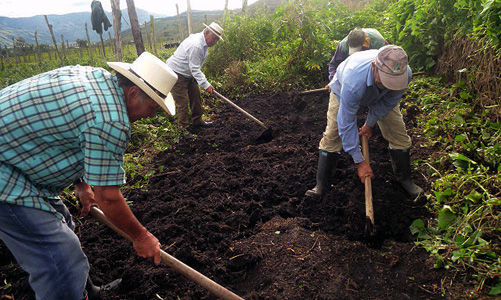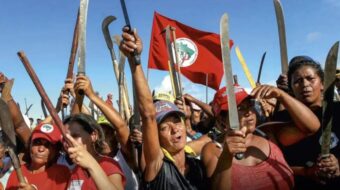
The current agrarian strike in Colombia follows one earlier in the Catatumbo region where small farmers mobilized for land and sustainable lives. Now angry small farmers are rejecting free trade agreements Colombia signed with the United States, Canada, and the European Union.
Indeed, rural people in Colombia are suffering. The rate of poverty is 80 percent, of extreme poverty, 25 percent. Eight million Colombians are hungry. Human rights abuses and killings are well known.
On August 8 outside the Agriculture Ministry in Bogota, leaders of the Table of Agrarian Discussion (MIA) issued demands and announced a strike. Death threats from paramilitaries showed up in their emails afterwards. MIA includes Patriotic March, a two-year-old amalgam of 1,500 social and political groups that organized 60 percent of the protest actions that followed.
Beginning on Aug. 19, 200,000 farmers, farm workers, truckers, and small miners have been demonstrating and blocking highways in most Colombian departments. Urban protesters joined in after Aug. 25. State repression at the hands of riot police and soldiers intensified the face-off. By Sept. 1, nine protesters were dead, 200 wounded, and hundreds detained. The turn to military intervention recalls the prevailing theme in Colombian history of struggle over land attended by violent conflict. That’s the essence of negotiations now going on in Cuba between the Colombian government and FARC insurgents.
“The national strike as such does not exist,” said President Juan Manuel Santos on Aug. 25. Four days later after demonstrations broke out in Bogota, Tolima, and elsewhere, Santos abandoned his presidential residence and settled into police headquarters. Bogota came under military rule, and 50,000 troops were deployed to keep highways open. The government offered pay for information leading to the arrests of protest leaders.
On Aug. 29 tear gas, clubs, helicopters, and armored vehicles blanketed Bogota. In Boyacá, police invaded homes and stole money and food. Torture and sexual abuse emerged, along with indiscriminate use of gas, explosives, and firearms. Videos circulated showing “the police urinating on demonstrators’ food, breaking windows, destroying homes, hitting and humiliating people in their own houses, wounding children, women, and old people, and infiltrating marches.” Spanish language abilities are not needed to understand the video: “Collection of videos: abuse by Colombian authorities.”
The government began negotiations with regional groups of farmers, particularly those in Boyacá, Nariño, and Cundinamarca. Land is fertile there, and farmers produce vegetables, grains, meat, and dairy products for the domestic market. Free trade agreements have hurt them. Colombian food imports from the United States were up 81 percent in the first year under the Colombian-U.S. free trade agreement. Tunja archbishop Luis Augusto Castro condemned the agreements as “treason to the country.“
But in other regions small farmers are asking for more: “They are demanding land and peasant reserve zones, indigenous peoples want reservations, and Afro-Colombians and [other] popular sectors want rights.” As in Catatumbo, land they occupy is coveted for natural resources extraction, ranching, and industrial agriculture.
The government has used the “lack of centralization of the movement – which is its great weakness – to mount sectional and regional negotiations,” reports one observer. Patriotic March leader Andrés Gil earned President Santos’ ire by charging that regional negotiations were aimed at dividing the protest movement. These talks deal with subsidies, tariff adjustments, and lowered fertilizer and herbicide prices rather than structural changes.
The agrarian strike expanded after Aug. 25, with students, unionists, and human rights activists filling city streets. Speaking to a reporter, one student denounced “handing over our country and doing away with agriculture,” but added: “No more privatized universities, no more fee increases.” The Broadened National Student Federation launched demonstrations in several cities. The University Professors Union denounced free trade agreements and called for a national constituent assembly. The Workers’ Labor Union (USO) and the Fensuagro agricultural workers union organized demonstrations.
Fensuagro Vice President Huber Ballesteros, spokesperson for the MIA, was jailed on Aug. 25, charged with “rebellion and terrorism.” Authorities use that allegation to link opposition leaders to the FARC. Ballesteros is now a magnet for international solidarity.
The government is stymied. Committed to market ideology, the oligarchy cannot resolve agrarian conflict without resort to violence, one commentator says. “[W]ith giant steps they are getting close to a revolutionary type crisis. And social leadership of a new type has arrived.”
Tolima hospital workers union President Nelsy Gómez Oliveros agrees: “President Santos … We are here in the streets for health care, education, the environment, jobs, and dignity as Colombian people. No more attacks! No more violence! No more war! … [T]oday we the Colombian people are showing we have blood in our veins and that we are inclined toward struggle, even to sacrifice.”
Photo: Colombian farmers prepare land for a nursery. Trees ForTheFuture CC 2.0










